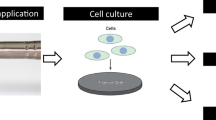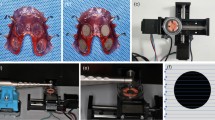Abstract
Erbium:yttrium–aluminum–garnet (Er:YAG) laser treatment is an effective option for the removal of bacterial plaques. Many studies have shown that Er:YAG lasers cannot re-establish the biocompatibility of titanium surfaces. The aim of this study was to evaluate the responses of the human osteoblast-like cell line, SaOs-2, to sand-blasted and acid-etched (SLA) titanium surface irradiation using different energy settings of an Er:YAG laser by examining cell viability and morphology. Forty SLA titanium disks were irradiated with an Er:YAG laser at a pulse energy of either 60 or 100 mJ with a pulse frequency of 10 Hz under water irrigation and placed in a 24-well plate. Human osteoblast-like SaOs-2 cells were seeded onto the disks in culture media. Cells were then kept in an incubator with 5 % carbon dioxide at 37 °C. Each experimental group was divided into two smaller groups to evaluate cell morphology by scanning electron microscope and cell viability using 3-4,5-dimethylthiazol 2,5-diphenyltetrazolium bromide test. In both the 60 and the 100 mJ experimental groups, spreading morphologies, with numerous cytoplasmic extensions, were observed prominently. Similarly, a majority of cells in the control group exhibited spreading morphologies with abundant cytoplasmic extensions. There were no significant differences among the laser and control groups. The highest cell viability rate was observed in the 100 mJ laser group. No significant differences were observed between the cell viability rates of the two experimental groups (p = 1.00). In contrast, the control group was characterized by a significantly lower cell viability rate (p < 0.001). Treatments with an Er:YAG laser at a pulse energy of either 60 or 100 mJ do not reduce the biocompatibility of SLA titanium surfaces. In fact, modifying SLA surfaces with Er:YAG lasers improved the biocompatibility of these surfaces.






Similar content being viewed by others
References
BeKer W, Beker BE, Newman MG, Nyman S (1990) Clinical and microbiological findings that may contribute to dental implant failure. Int J Oral Maxillofac Implants 5(1):31–38
Mombelli A, Buser D, Lang NP (1988) Colonization of osseointegrated titanium implants in the edentulous patients. Early results. Oral Microbiol Immunol 3(3):113–120
Thomson-Neal D, Evans GH, Meffert RM (1989) Effects of various prophylactic treatments on titanium, sapphire, and hydroxyapatite-coated implants: an SEM study. Int J Periodontics Restorative Dent 9(4):300–311
Fox SC, Moriarty JD, Kusy RP (1990) The effects of scaling a titanium implant surface with metal and plastic instruments: an in vitro study. J Periodontol 61(8):485–490
Karring ES, Stavropoulos A, Ellegaard B, Karring T (2005) Treatment of peri-implantitis by the vector system. Clin Oral Implants Res 16(3):288–293
Schwarz F, Rothamel D, Sculean A, Georg T, Scherbaum W, Beker J (2003) Effects of an Er:YAG laser and the vector ultrasonic system on the biocompatibility of titanium implants in cultures of human osteoblast-like cells. Clin Oral Implants Res 14(6):784–792
Kreisler M, Gotz H, Dushner H, d’Hoedt B (2002) Effects of Nd:YAG, Ho:YAG,Er:YAG,CO2 and GaAIAs laser irradiation on surface properties of endosseous dental implants. Int J Oral Maxillofac Implants 17:202–211
Kreisler M, Kohnen W, Marrinello C, Gotz H, Duschner H, Janson B, d’Hoedt B (2002) Bactericidal effect of the Er:YAG laser on dental implant surfaces: an in vitro study. J Periodontol 73:1292–1296
Takasaki A, Aoki A, Mizutani K, Kikuchi S, Oda S, Ishikawa I (2007) Er:YAG laser therapy for peri-implant infection: a histological study. Laser Med Sci 22:143–157
Kreisler M, Kohnen W, Christofers A, Gotz H, Jansen B, Duschner H, Hoedt B (2005) In vitro evaluation of the biocompatibility of contaminated implant surfaces treated with an Er:YAG laser and an air powder system. Clin Oral Implant Res 16:36–43
Gaggl A, Schultes G, Müller WD, Kärcher H (2000) Scanning electron microscopical analysis of laser-treated titanium implant surfaces—a comparative study. Biomaterials 21(10):1067–1073
Cho SA, Jung SK (2003) A removal torque of the laser-treated titanium implants in rabbit tibia. Biomaterials 24(26):4859–4863
Cei S, Legitimo A, Barachini S, Consolini R, Sammartino G, Mattii L, Gabriele M, Graziani F (2011) Effect of laser micromachining of titanium on viability and responsiveness of osteoblast-like cells. Implant Dent 20(4):285–291
Khosroshahi ME, Mahmoodi M, Saeedinasab H (2009) In vitro and in vivo studies of osteoblast cell response to a titanium-6 aluminium-4 vanadium surface modified by neodymium: yttrium–aluminium–garnet laser and silicon carbide paper. Laser Med Sci 24:925–939
Guo Z, Zhou L, Rong M, Zhu A, Geng H (2010) Bone response to a pure titanium implant surface modified by laser etching and microarc oxidation. Int J Oral Maxillofac Implants 25(1):130–136
Schwarz F, Sculean A, Romanos G, Herten M, Horn N, Scherbaum W, Beker J (2005) Influence of different treatment approaches on the removal of early plaque biofilms and the viability of SAOS2 osteoblasts grown on titanium implants. Clin Oral Invest 9:111–117
Schwarz F, Papanicolau P, Rothamel D, Beck B, Herten M, Becker J (2006) Influence of plaque biofilm removal on reestablishment of the biocompatibility of contaminated titanium surfaces. J Biomed Mater Res 77a:437–444
Galli C, Macaluso GM, Elezi E, Ravanetti F, Cacchioli A, Gualini G, Passeri G (2011) The effects of Er:YAG laser treatment on titanium surface profile and osteoblastic cell activity: an in vitro study. J Periodontol 82(8):1169–1177. doi:10.1902/jop.2010.100428, Epub 2010 Dec 28
Ando Y, Aoki A, Watanabe H, Ishikawa I (1996) Bactericidal effect of erbium YAG laser on periodontopathic bacteria. Lasers Surg Med 19(2):190–200
Kreisler M, Al Haj H, dHoedt B (2002) Temperature changes at the implant–bone interface during simulated surface decontamination with an Er:YAG laser. Int J Prosthodont 15(6):582–587
Stubinger S, Etter C, Miskiewicz M, Homann F, Saldamli B, Wieland M, Sader R (2010) Surface alterations of polished and sandblasted and acid-etched titanium implants after Er:YAG, carbon dioxide, and diode laser irradiation. Int J Oral Maxillofac Implants 25:104–111
Lee J-H, Kwon Y-H, Herr Y, Shin S-I, Chung J-H (2011) Effect of erbium-doped: yttrium, aluminium and garnet laser irradiation on the surface microstructure and roughness of sand-blasted, large grit, acid-etched implants. Periodontal Implant Sci 41(3):135–142
Shin SI, Min HK, Park BH, Kwon YH, Park JB, Herr Y, Heo SJ, Chung JH (2011) The effect of Er:YAG laser irradiation on the scanning electron microscopic structure and surface roughness of various implant surfaces: an in vitro study. Lasers Med Sci 26(6):767–776, Epub 2010 Aug 6
Romanos G, Crespi R, Barone A, Covani U (2006) Osteoblast attachment on titanium disks after laser irradiation. Int J Oral Maxillofac Implants 21(2):232–236
Ishikawa I, Aoki A, Takasaki AA (2004) Potential applications of erbium:YAG laser in periodontics. J Periodontal Res 39(4):275–285
Schwarz F, Nuesry E, Bieling K, Herten M, Becker J (2006) Influence of an erbium, chromium-doped yttrium, scandium, gallium, and garnet (Er,Cr:YSGG) laser on the reestablishment of the biocompatibility of contaminated titanium implant surfaces. J Periodontol 77:1820–1827
Zhu X, Chen J, Scheideler L, Reichl R, Geis Gerstorfer J (2004) Effects of topography and composition of titanium surface oxides on osteoblast response. Biomaterials 25(18):4087–4103
Inoue T, Cox JE, Pilliar RM, Melcher AH (1987) Effect of surface geometry of smooth and porous coated titanium alloy on the orientation of fibroblasts in vitro. J Biomed Mater Res 21(1):107–126
Sennerby L, Lekholm U (1993) The soft tissue response to titanium abutments retrieved from humans and reimplanted in rats. A light microscopic study. Clin Oral Implants Res 4(1):23–27
Baier RE, Meyer AE (1988) Implant surface preparation. Int J Oral Maxillofac Implants 3(1):9–20
Zinger O, Anselme K, Denzer A, Habersetzer P, Wieland M, Jeanfils J, Hardouin P, Landolt D (2004) Time-dependent morphology and adhesion of osteoblastic cells on titanium model surfaces featuring scale-resolved topography. Biomaterials 25(14):2695–2711
Keller JC, Draughn RA, Wightman JP, Dougherty WJ, Meletiou SD (1990) Characterization of sterilized CP titanium implant surfaces. Int J Oral Maxillofac Implants 5(4):360–367
Perez del Pino A, Serra P, Morenzo JL (2002) Oxidation of titanium through Nd:YAG laser irradiation. Appl Surf Sci 8129:1–4
Acknowledgments
This study was supported financially by the Dental Branch of Islamic Azad University in Tehran, Iran. The authors express their appreciation to the Dorsan Teb Pars Company of Iran and Dentium Company of the Republic of Korea for kindly providing the titanium disks for this study.
Disclosure
The authors have no financial interests in any of the companies or products mentioned in this article.
Author information
Authors and Affiliations
Corresponding author
Rights and permissions
About this article
Cite this article
Ayobian-Markazi, N., Fourootan, T. & Zahmatkesh, A. An in vitro evaluation of the responses of human osteoblast-like SaOs-2 cells to SLA titanium surfaces irradiated by erbium:yttrium–aluminum–garnet (Er:YAG) lasers. Lasers Med Sci 29, 47–53 (2014). https://doi.org/10.1007/s10103-012-1224-y
Received:
Accepted:
Published:
Issue Date:
DOI: https://doi.org/10.1007/s10103-012-1224-y




